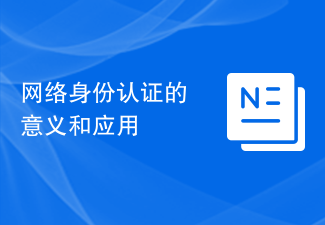 Java
Java javaTutorial
javaTutorial A case study on the practical application of Java callback functions in GUI development
A case study on the practical application of Java callback functions in GUI development
Practical application scenarios of Java callback functions in GUI development
Introduction
The callback function is a function that is called when an event occurs. In GUI development, callback functions are often used to respond to user interactions, such as button clicks, text input, mouse movements, etc. By using callback functions, we can let the GUI program respond to user operations to implement various interactive functions.
Specific code example
Button click event
import javax.swing.*;
import java.awt.event.*;
public class ButtonClickExample {
public static void main(String[] args) {
// 创建一个按钮
JButton button = new JButton("Click Me!");
// 为按钮添加点击事件监听器
button.addActionListener(new ActionListener() {
@Override
public void actionPerformed(ActionEvent e) {
// 当按钮被点击时,执行以下代码
JOptionPane.showMessageDialog(null, "Button clicked!");
}
});
// 创建一个JFrame并添加按钮
JFrame frame = new JFrame("Button Click Example");
frame.add(button);
frame.setSize(300, 200);
frame.setLocationRelativeTo(null);
frame.setDefaultCloseOperation(JFrame.EXIT_ON_CLOSE);
frame.setVisible(true);
}
}In this example, we create a button and add a click event listener to it. When the button is clicked, the code in the listener will be executed, displaying a message dialog.
Text Input Event
import javax.swing.*;
import java.awt.event.*;
public class TextInputExample {
public static void main(String[] args) {
// 创建一个文本框
JTextField textField = new JTextField();
// 为文本框添加文本输入事件监听器
textField.addKeyListener(new KeyListener() {
@Override
public void keyTyped(KeyEvent e) {
// 当用户在文本框中输入字符时,执行以下代码
System.out.println("Key typed: " + e.getKeyChar());
}
@Override
public void keyPressed(KeyEvent e) {
// 当用户按下键盘上的某个键时,执行以下代码
System.out.println("Key pressed: " + e.getKeyCode());
}
@Override
public void keyReleased(KeyEvent e) {
// 当用户松开键盘上的某个键时,执行以下代码
System.out.println("Key released: " + e.getKeyCode());
}
});
// 创建一个JFrame并添加文本框
JFrame frame = new JFrame("Text Input Example");
frame.add(textField);
frame.setSize(300, 200);
frame.setLocationRelativeTo(null);
frame.setDefaultCloseOperation(JFrame.EXIT_ON_CLOSE);
frame.setVisible(true);
}
}In this example, we create a text box and add a text input event listener to it. When the user enters characters in the text box, presses a key on the keyboard, or releases a key on the keyboard, the code in the listener will be executed and the corresponding information will be output.
Mouse Move Events
import javax.swing.*;
import java.awt.event.*;
public class MouseMoveExample {
public static void main(String[] args) {
// 创建一个面板
JPanel panel = new JPanel();
// 为面板添加鼠标移动事件监听器
panel.addMouseMotionListener(new MouseMotionListener() {
@Override
public void mouseMoved(MouseEvent e) {
// 当鼠标在面板中移动时,执行以下代码
System.out.println("Mouse moved: (" + e.getX() + ", " + e.getY() + ")");
}
@Override
public void mouseDragged(MouseEvent e) {
// 当鼠标在面板中被拖动时,执行以下代码
System.out.println("Mouse dragged: (" + e.getX() + ", " + e.getY() + ")");
}
});
// 创建一个JFrame并添加面板
JFrame frame = new JFrame("Mouse Move Example");
frame.add(panel);
frame.setSize(300, 200);
frame.setLocationRelativeTo(null);
frame.setDefaultCloseOperation(JFrame.EXIT_ON_CLOSE);
frame.setVisible(true);
}
}In this example, we create a panel and add a mouse move event listener to it. When the mouse moves or is dragged in the panel, the code in the listener will be executed and the current position of the mouse will be output.
Summary
The callback function is a very important concept in GUI development. It allows us to make the GUI program respond to user operations, thereby realizing various interactive functions. In this article, we introduce the practical application scenarios of callback functions in GUI development and provide specific code examples. Hopefully these examples will help you better understand and use callback functions.
The above is the detailed content of A case study on the practical application of Java callback functions in GUI development. For more information, please follow other related articles on the PHP Chinese website!
 Gin框架中的错误处理及其应用场景Jun 23, 2023 pm 02:09 PM
Gin框架中的错误处理及其应用场景Jun 23, 2023 pm 02:09 PMGin框架是一款轻量级的Web框架,它具有高效、易用、灵活等优点。在使用Gin框架的过程中,错误处理是一个必须要考虑的问题。Gin框架提供了良好的错误处理机制,本文将探讨Gin框架中的错误处理及其应用场景。一、错误处理的意义错误处理是指在程序运行过程中,处理程序发现的错误及异常情况的过程。对于Web应用程序而言,错误处理是非常重要的,因为有时候用户会向服务器
 AMD SEV技术的应用场景Jun 11, 2023 am 09:52 AM
AMD SEV技术的应用场景Jun 11, 2023 am 09:52 AMAMDSEV(SecureEncryptedVirtualization)是AMD推出的一项硬件加密技术,旨在保护虚拟机(VM)中的数据安全。它通过将加密密钥保存在CPU内部并自动加密内存中的数据来实现这一目标。SEV技术的出现为云计算带来了更高级别的安全性,可以有效防止来自虚拟机监视器及其他虚拟机的攻击,同时也可以提供更多形式的安全性和隔离保护。AM
 Golang微服务开发适用于哪些应用场景?Sep 18, 2023 pm 12:25 PM
Golang微服务开发适用于哪些应用场景?Sep 18, 2023 pm 12:25 PMGolang微服务开发适用于哪些应用场景?随着云计算和微服务架构的兴起,越来越多的开发人员开始关注Golang(Go语言)在微服务开发中的应用。Golang是一种简洁、高效、并发性强的编程语言,因此在构建可扩展、高性能的微服务应用方面具有很大优势。那么,Golang适用于哪些应用场景呢?本文将介绍几个常见的场景,并提供相应的代码示例。1.Web应用程序Go
 刨析PHP数据缓存的工作原理及应用场景Aug 10, 2023 am 09:41 AM
刨析PHP数据缓存的工作原理及应用场景Aug 10, 2023 am 09:41 AM刨析PHP数据缓存的工作原理及应用场景随着互联网技术的不断发展,用户访问量的大幅增加,对于数据的处理能力和效率要求也越来越高。在PHP开发中,数据缓存技术被广泛应用,可以有效地提高网站性能和用户体验。本文通过分析PHP数据缓存的工作原理,结合实际应用场景,来深入了解如何使用数据缓存提升网站性能。一、PHP数据缓存的工作原理PHP数据缓存是将一些经常使用的数据
 人工智能:人工神经网络的应用场景知识介绍Apr 12, 2023 am 11:02 AM
人工智能:人工神经网络的应用场景知识介绍Apr 12, 2023 am 11:02 AM今天给大家聊一聊人工神经网络在几个领域的应用场景。一、信息领域应用1.1 信息处理人工神经网络可以模仿或者代替与人的思维相关的功能,实现问题求解、问题自动诊断,从而解决传统方法所不能或难以解决的问题,场景:智能仪器、自动跟踪监测仪器、自动报警系统、自动故障诊断系统等方面。1.2 模式识别模式识别主要是对事物或现象的各种形式的信息处理和分析,从而可以达到对事物或现象进行描述、辨认、分类、解释的过程。模式识别主要包括统计模式识别和结构模式识别方法,其中人工神经网络是模式识别的常用方法。场景:语音识别
 网络身份认证的意义和应用Jun 11, 2023 am 08:21 AM
网络身份认证的意义和应用Jun 11, 2023 am 08:21 AM随着互联网的发展,我们每天都在网上进行着各种操作,如购物、社交、学习等。而网络身份认证已经成为我们日常生活中不可或缺的一部分。本文将详细介绍网络身份认证的意义和应用。一、网络身份认证的意义网络身份认证是指在互联网上,通过一定的认证方式来确定用户的身份信息,从而确保用户能够安全地进行各种操作。网络身份认证的重要性在于以下几点:1.防止身份盗用网络身份认证可以防
 Redis在Web应用中的应用场景分析Jun 21, 2023 pm 04:18 PM
Redis在Web应用中的应用场景分析Jun 21, 2023 pm 04:18 PMRedis是一款基于内存的开源分布式键值存储系统,被广泛的应用于Web应用中,提供了许多有利的特性:高并发性、快速响应、可扩展性、持久性、数据类型多样性以及丰富的API等。本文将对Redis在Web应用中的应用场景进行分析。缓存缓存是Redis最为常见的应用场景之一,对于Web应用来说,如果需要频繁读取数据库中的数据,会造成数据库的瓶颈,导致性能不佳。这时候
 人工智能:智能语音技术应用场景Apr 11, 2023 pm 07:40 PM
人工智能:智能语音技术应用场景Apr 11, 2023 pm 07:40 PM智能语音技术是市场上人工智能产品应用最为广泛的技术,今天给大家聊聊智能语音技术常见的应用场景,希望对大家能有所帮助!1、智能客服智能客服是基于大规模知识处理基础上发展起来的,它具有较强的行业通用性,可以为企业提供细粒度知识管理技术、用户和企业沟通的有效技术手段、还可以提供相应的客户沟通统计分析、也可以节约一定的人工成本。常见的有京东智能客服、淘宝智能客服等等。2、智能车载智能车载系统可以大大方便了我们的日常出行,常见的功能有实时更新地图、语音技术进行导航、语音播放音乐新闻、手机远程控制可以让那


Hot AI Tools

Undresser.AI Undress
AI-powered app for creating realistic nude photos

AI Clothes Remover
Online AI tool for removing clothes from photos.

Undress AI Tool
Undress images for free

Clothoff.io
AI clothes remover

AI Hentai Generator
Generate AI Hentai for free.

Hot Article

Hot Tools

mPDF
mPDF is a PHP library that can generate PDF files from UTF-8 encoded HTML. The original author, Ian Back, wrote mPDF to output PDF files "on the fly" from his website and handle different languages. It is slower than original scripts like HTML2FPDF and produces larger files when using Unicode fonts, but supports CSS styles etc. and has a lot of enhancements. Supports almost all languages, including RTL (Arabic and Hebrew) and CJK (Chinese, Japanese and Korean). Supports nested block-level elements (such as P, DIV),

Dreamweaver CS6
Visual web development tools

SublimeText3 Mac version
God-level code editing software (SublimeText3)

SublimeText3 Linux new version
SublimeText3 Linux latest version

SublimeText3 English version
Recommended: Win version, supports code prompts!






